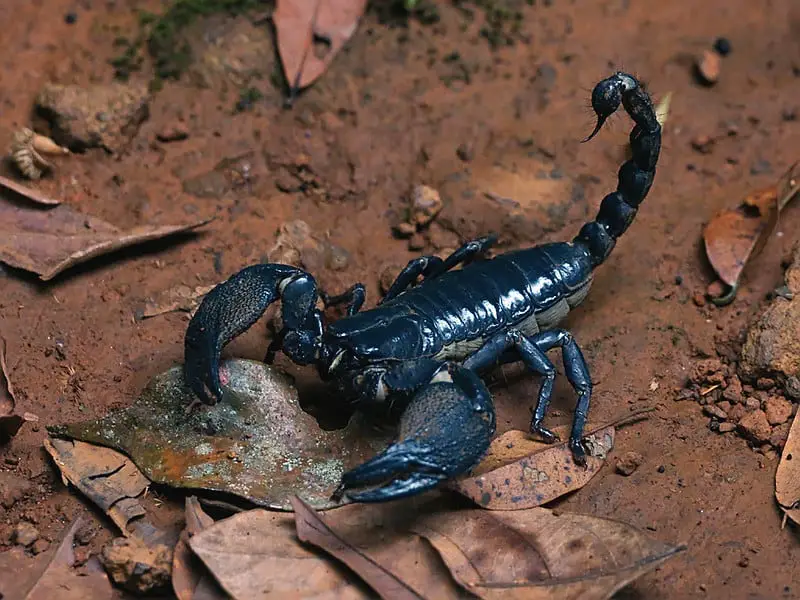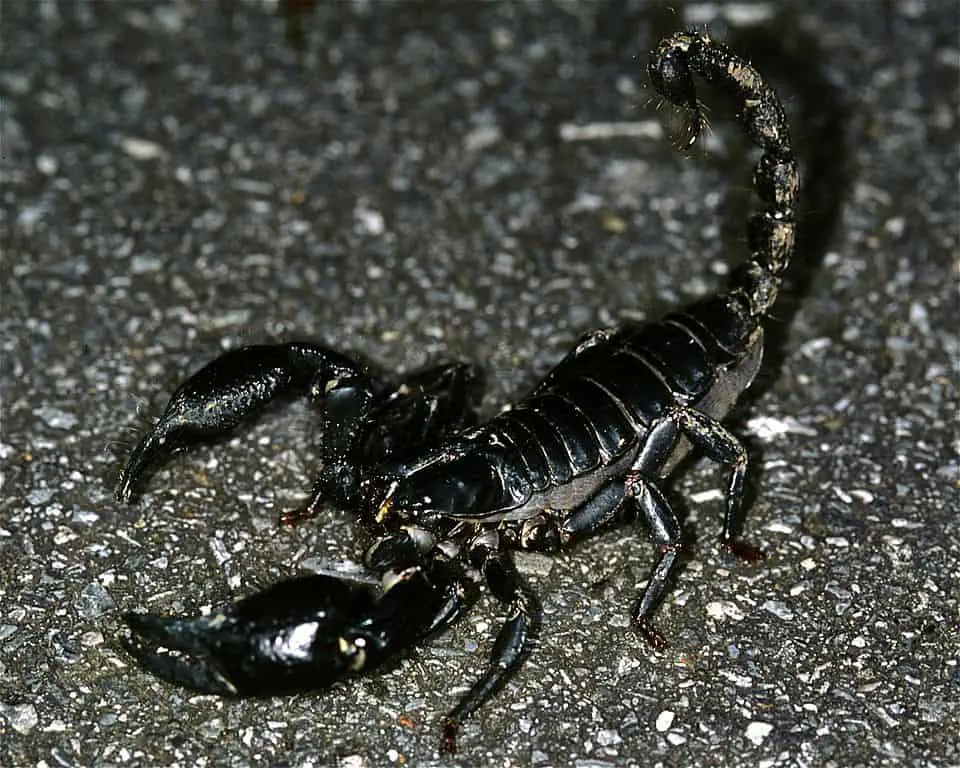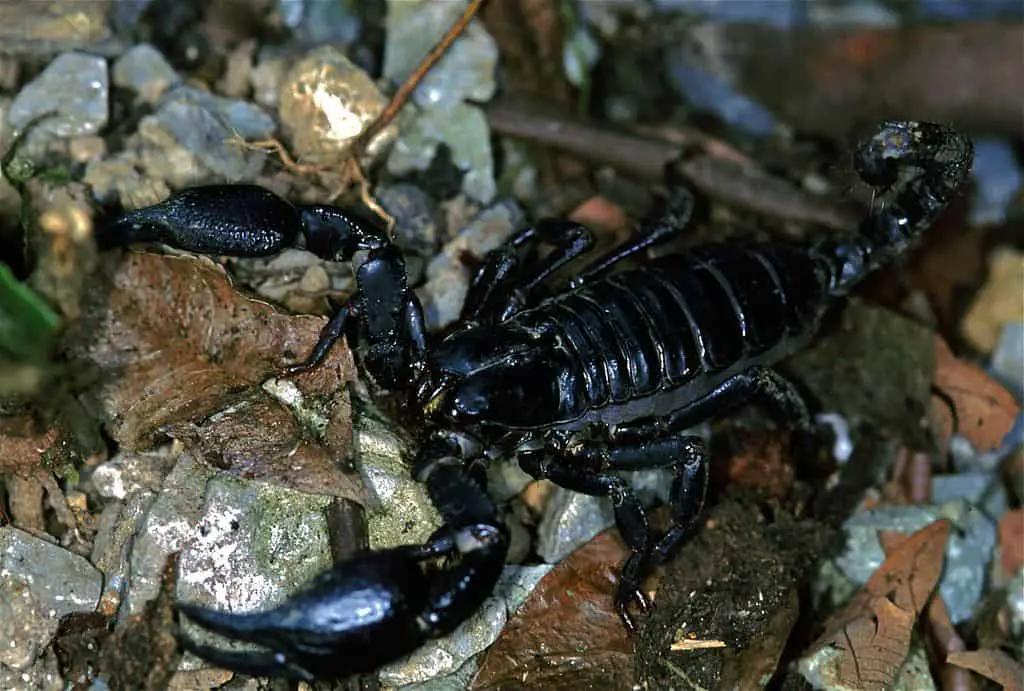The Asian Forest Scorpion (Heterometrus spinifer) is a species of scorpions belonging to the Scorpionidae family. It’s a terrestrial scorpion that lives on the forest floors of India, Malaysia, and India. However, due to their striking appearance and large size, they’ve also become very popular among hobbyists.
They’re an excellent species for beginners to the hobby due to their large size, mild venom, and ease of care.
If the Asian Forest Scorpion has caught your eye and you’re considering taking one into your home as a pet, you’ve come to the right place. Here, you’ll find everything you need to know about these fearsome scorpions.

Asian Forest Scorpion Care Sheet
| Name of Species | Heterometrus spinifer |
| Family | Scorpionidae |
| Common names | Asian Forest Scorpion, Giant Blue Scorpion, Giant Forest Scorpion |
| Type | Terrestrial |
| Native location | India, Malaysia, Indonesia |
| Size | 5 inches |
| Growth Rate | Medium |
| Lifespan | 7 to 8 years |
| Experience required | Beginner |
| Venom | Mild |
| Minimum tank size | 20”L x 10”W x 12”H |
Asian Forest Scorpion Overview
The Heterometrus spinifer is commonly known as the Asian Forest Scorpion (AFS). It’s an arachnid that lives in Southeast Asia. There, they roam the forest floors in search of prey. During the day, they spend the majority of their time in their burrow, but they come out at night
Appearance

The Asian Forest Scorpions has a beautiful, shiny black body with gray/greenish reflections in the right light. They also have very large pincers and a large body which makes them very popular among hobbyists.
They’re relatively similar in appearance to the Emperor Scorpion, which has resulted in a lot of confusion. If you’re ever unsure which species you’re looking at, take a look at their stinger. The AFS has a black stinger, whereas the Emperor has a yellow to red-brown one.
The AFS is a relatively big species, topping out at a size of around 5 inches. It can be difficult to tell the difference between males and females because they look very similar. The main difference is that males tend to be thinner and faster.
Asian Forest Scorpion Price
The AFS is not a particularly expensive species. They’re very popular in the hobby, and there are a lot of breeders who breed them, which makes them widely available.
They can be found for as little as $12 to $25, making them very affordable.
Temperament & Behavior
The Asian Forest Scorpion has a relatively defensive temperament. They’re not aggressive by any means, but they will use their claws when they feel annoyed or agitated.
Like other scorpions, they also have a stinger that they can use to defend themselves. They can inject venom with their stinger, but the venom they inject is relatively weak. If you’re not allergic, it will not be dangerous to a healthy human.
They are nocturnal animals and will spend the vast majority of the day hidden away in their burrows, but they will come out at night.
Keep in mind that scorpions are not social animals like cats or dogs. They do not crave human attention or affection and would prefer to be left alone as much as possible. Therefore, you shouldn’t try to pet or touch your Asian Forest Scorpion. They’re best observed, not touched.
Caring for an Asian Forest Scorpion

Asian Forest Scorpions are relatively easy to care for. All they really need is a good enclosure that has a pleasant temperature and humidity, good substrate, food, and water.
Tank setup
The AFS is a relatively large scorpion so they need an enclosure that befits their size. At a minimum, give them a terrarium that’s 20 inches long, 10 inches wide, and 10 inches high. This should provide adequate space for them.
You should also provide at least 2 hiding spots for them and decorative elements such as twigs, branches rocks, and live or artificial plants.
Temperature & humidity
The ideal temperature to keep an Asian Forest Scorpion in is between 72 and 90 degrees °F. If you have a particularly cold house where the temperature regularly goes below 72 °F, you might want to use supplemental heating such as a heating pad.
When using supplemental heating, it’s a good idea to place it at the side of the enclosure, rather than the top or bottom. That way, your scorpion can get closer or further away from the heat if they’re getting too hot or too cold.
As for humidity, try to keep it between 70 and 80%. To keep humidity levels high, you can moisturize the substrate. Alternatively, you can mist the enclosure with water. Spaghnum moss is also a great way to increase the moisture in the enclosure.
Substrate
Since this species has a tendency to burrow, it’s important to provide them with substrate that allows them to do so. Good materials to use as substrate include peat moss and organic topsoil, mixed with a little bit of sand. Alternatively, you can use Zoo Med Eco Earth, Zoo Med Reptisoil, BioDude terra arena, or Exo Terra plantation soil.
Fill about half of their enclosure with this substrate so that you have a layer of around 3 to 4 inches thick.
The substrate should be kept moist, but not swampy.
Social
The AFS is capable of communal living, but it’s definitely not the case that they need other members of their species in their enclosure to be happy. They’re by no means social animals, but it is possible for two or more of them to live in the same enclosure as long as they’re provided with plenty of food and enough space to not get in each other’s way.
Nevertheless, territorial behavior can still occur, which can lead to fights. As such, it’s typically best to house them solitarily.
If you do house them communally, make sure to keep an eye on them to see how it goes and provide them with a lot of space, hides, and food.
Feeding your Asian Forest Scorpion
Asian Forest Scorpions have a decent appetite and can eat quite a bit. You can give an adult 3 large crickets every 10 to 14 days. They can also eat other insects, such as mealworms or dubia roaches.
When raising juveniles, it’s important that you make sure that the size of the prey items does not exceed three-quarters of the scorpion’s length. If the prey is too large, the scorpion won’t be able to eat them.
Not all scorpions need the same amount of food. Keep an eye on their size to figure out whether you’re feeding them enough. If they look skinny you should increase their food intake, and if they start to look plump you might want to feed them a little less.
It’s important that you remove uneaten prey items after 24 hours to prevent the growth of mold and bacteria.
Of course, they also need to stay hydrated. To allow them to drink, provide them with a water bowl that you replenish with fresh water often. Make sure that the bowl is shallow so that your scorpion can get out of it if it accidentally falls in.
Lifespan & Health
The Asian Forest Scorpion is a very healthy and hardy species. In captivity, they can easily reach a lifespan of 7 to 8 years.
To keep them in good health, make sure that you feed them only captive-bred insects as wild-caught insects often contain parasites.
Also, keep their enclosure clean, and remove uneaten food in a timely matter to avoid the growth of bacteria, mites, and mold.
Final words: Is the Asian Forest Scorpion right for you?
The Asian Forest Scorpion is a beautiful, hardy species that are many people’s introduction to the scorpion-keeping hobby. While they’re a little more defensive than the Emperor Scorpion, they’re still a relatively laid-back species. This, combined with their large size, impressive claws, and mild venom, makes them a very suitable scorpion for beginners.
They’re also quite easy to care for. As long as you provide them with the basics, they’ll be able to thrive without any issues.
- How Long Do American Eskimo Dogs Live? Important Factors and Care Tips - September 29, 2023
- Do American Bulldogs Need Grooming? Essential Tips and Care Guidelines - September 29, 2023
- Do Bengal Cats Enjoy Playing? Essential Tips for Keeping Them Active - September 29, 2023